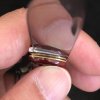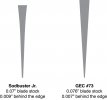I'm pretty certain this is not true.
Buck's old semi-hollow grind is interesting and worth studying, IMO. It actually flares out and gets thicker just above the edge to make the edge stronger. Hence the old Al Buck trick of battoning a Buck knife through a bolt on an anvil. Virtuovice (YouTuber) discusses the virtues of low convex vs high convex for bushcraft and deer processing respectively.
Regarding a full height hollow grind, I'm not sure many (any?) makers seek this as a design goal. JackBlack has discussed this off and on over the years in the traditional forum based on his interest in documenting the history of the early Sheffield (England) knife factories. His point (iirc) is that in earlier knife making, the distinction between what we are calling "full flat" and "full height hollow" would have just been chalked up to who was doing the grinding that day. He describes the typical grinding as very large radius grinding stones driven by water power and grinders who laid flat on a platform above the wheels as they worked.
This confusion continues to this day. The Case Sodbuster is often mentioned as an example of a "full height hollow grind" but when I asked the question 4 years ago, some people asserted that a straight edge showed their to be full flat and others slightly hollow. To this day, I don't think Case says which the consider it and it appears that whether a Sodbuster is flat or slightly hollow depends again on who was doing the grinding.
https://www.bladeforums.com/threads/case-large-sodbuster-grind.1235763/
I think an interesting historical question to think about is when the (saber) hollow grind became common. Based on my (modest) collection of vintage Schrades, I would think the roll-over would be in the late 60s. Buck also transitioned away from their early saber flat grinds to hollow (or semi-hollow) grinds. My hunch is that the availability of high speed, small radius grinders combined with crude process automation made the (saber) hollow grind possible during that time period as a mass produced item.
And it is at this point that I can suggest 2 more benefits of the (saber) hollow grind.
1) They look cool. Buck, following the inspiration of Leroy Remer, certainly has used sharply defined and often curving hollow grind shoulders as an aesthetic feature on their knives. Ditto false edges too. The Buck Reaper looks more cool than the full flat and squared spine Buck/Ron Hood Thug. Hood designed a better survival knife but Buck makes a better seller because huge numbers of people buy on looks.
2) Hollow grinds are easier for people with poor sharpening skills to keep sharp. As I understand it, this is one reason why Buck gave up on the semi-hollow grind. People had a hard time sharpening them because the blades were actually pretty thick behind the edge.





 Buck 110
Buck 110